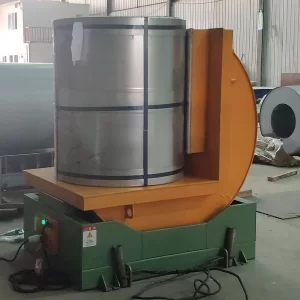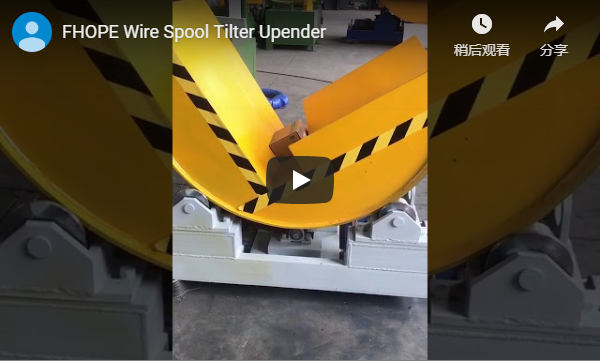Handling large, heavy wire spools presents significant challenges in manufacturing, cable industries, and warehousing logistics. Manual manipulation is often impractical and poses substantial safety risks. The FHOPE Wire Spool Tilter Upender emerges as a robust engineering solution, designed specifically to automate and secure the process of tilting and repositioning heavy spools, enhancing both operational efficiency and workplace safety. This machine provides precise control for loading, unloading, feeding production lines, and optimizing storage.
1. Technical Specifications and Design Analysis
The FHOPE-FZ model exemplifies a dedicated approach to heavy-duty material handling. Its design prioritizes durability, operational smoothness, and operator safety.
Key Technical Data (Model FHOPE-FZ - Representative):
- Machine Type: Hydraulic Wire Spool Tilter Upender
- Model: FHOPE-FZ
- Year of Manufacture: 2023 (Illustrative)
- Condition: New
- Load Capacity: Up to 1000kg (Customizable)
- Maximum Spool Diameter: Ø1200mm (Variable based on configuration)
- Maximum Spool Width: 800mm (Variable based on configuration)
- Tilt Angle: 0 - 90 degrees
- Tilting Speed: Approx. 15-30 seconds (Adjustable)
- Operation Type: Electro-Hydraulic
- Control System: Push-button panel (Standard), Optional PLC control with HMI
- Power Requirements: 380V/50Hz/3-Phase (Customizable, e.g., 220V/60Hz/1-Phase or 3-Phase)
- Hydraulic Motor Power: 1.5 kW - 3.0 kW (Depending on capacity)
- Hydraulic System Pressure: 12-16 MPa (Adjustable)
- Hydraulic Fluid: ISO VG 46 Anti-wear Hydraulic Oil
- Machine Dimensions (LxWxH): Approx. 1500mm x 1200mm x 1400mm (Subject to customization)
- Machine Weight: Approx. 500kg - 800kg
- Base Frame Construction: Reinforced heavy-gauge structural steel, welded frame
- Platform Surface: Steel plate, optional V-shape cradle or custom fixtures
- Finish: Industrial enamel paint, powder coating optional
- Safety Standards Compliance: CE marking (optional), adherence to local safety regulations
Disclaimer: The parameters listed above are indicative for the FHOPE-FZ model range. Specific configurations may vary. For precise specifications matching your requirements, please contact FHOPE directly.

2. Core Components and Functional Breakdown
The reliability and performance of the FHOPE Tilter stem from its well-engineered components:
- Hydraulic Power Unit (HPU): Comprises an electric motor driving a hydraulic pump, oil reservoir, valves, and filters. This unit generates the necessary force for the tilting motion, ensuring smooth and controlled operation.
- Tilting Platform/Cradle: The structure that directly supports the wire spool. Constructed from heavy-duty steel, it's designed to securely hold the spool during the 90-degree tilt. Custom cradles can accommodate specific spool types or core diameters.
- Hydraulic Cylinders: Typically one or two robust cylinders provide the mechanical actuation for tilting the platform. Dual cylinders offer enhanced stability and balanced lifting, especially for heavier loads.
- Control Panel: Features intuitive controls (e.g., Up/Down push buttons, Emergency Stop). More advanced systems may include a PLC for automated sequences or integration with other machinery.
- Base Frame: Provides a stable foundation for the entire machine, ensuring safe operation even under maximum load. It's designed for floor mounting.
- Safety Mechanisms: Essential features include:
- Emergency Stop Button: Immediately halts all motion.
- Hydraulic Check Valves / Anti-Fall Locks: Prevent the platform from unintentionally lowering in case of hydraulic pressure loss.
- Limit Switches: Define the end points of the tilting motion.
- Overload Protection: Integrated within the hydraulic system to prevent operation beyond rated capacity.
3. Operational Efficiency and Ergonomic Benefits
Integrating the FHOPE Wire Spool Tilter Upender yields tangible improvements:
- Reduced Manual Handling: Virtually eliminates the strenuous and hazardous task of manually tilting heavy spools, significantly lowering the risk of musculoskeletal injuries.
- Enhanced Safety: Controlled hydraulic movement and built-in safety features minimize the potential for accidents associated with spool handling.
- Increased Productivity: Faster and more efficient spool orientation reduces machine setup times and overall process cycle times. Consistent positioning aids downstream processes.
- Minimized Product Damage: Gentle and controlled tilting action prevents damage to sensitive wires or cables often caused by rough manual handling or dropping.
- Improved Workflow: Streamlines the transition of spools between storage (horizontal or vertical) and production/shipping (vertical or horizontal), optimizing logistical flow.
4. Key Applications Across Industries
The versatility of the FHOPE Tilter makes it suitable for various industrial environments:
- Wire and Cable Manufacturing: Essential for tilting bulk supply spools (e.g., copper, aluminum wire) for feeding into drawing, stranding, or extrusion lines. Also used for positioning finished cable reels for testing or packaging.
- Metal Processing and Stamping: Handling coils of steel, aluminum, or other metals. Tilting allows for easier loading onto decoilers or uncoilers feeding press lines or slitting machines.
- Warehousing and Logistics: Facilitates safe and efficient storage and retrieval. Allows spools stored flat (eye-to-sky) to be tilted for vertical storage (maximizing space) or tilted upright for transport or dispensing. Improves inventory management and order picking processes.
- Paper and Textile Industries: Handling large rolls of paper, film, or textiles, tilting them for processing or storage.
5. Integration and Customization Potential
The FHOPE Tilter is designed for seamless integration:
- Standalone Operation: Can be used as a dedicated tilting station.
- Line Integration: Can be positioned at the start or end of production lines, potentially integrating with conveyor systems or AGVs (Automated Guided Vehicles) for fully automated handling.
- Customization: FHOPE offers significant customization options, including:
- Load capacity adjustments.
- Platform dimensions and shapes (e.g., V-cradles, rollers).
- Specific control requirements (PLC, variable speed).
- Special paint finishes or materials (e.g., stainless steel for specific environments).
- Mobility options (e.g., adding wheels for repositioning).
6. Operator Experience and Ease of Use
Based on its design principles, operators using the FHOPE Tilter can expect:
- Intuitive Controls: Simple push-button operation minimizes training time and potential for errors.
- Smooth Operation: The hydraulic system provides a controlled, jerk-free tilting motion, enhancing operator confidence and safety.
- Reliability: Robust construction using high-quality components translates to dependable performance and minimal downtime.
- Improved Ergonomics: Reduces physical strain, contributing to a healthier and more sustainable work environment. Operators can focus on overseeing the process rather than performing strenuous physical labor.
7. Conclusion
The FHOPE Wire Spool Tilter Upender (Model FHOPE-FZ and variants) represents a critical piece of equipment for modern industrial operations dealing with heavy spools and reels. By combining robust engineering, precise hydraulic control, and integral safety features, it delivers significant improvements in operational efficiency, drastically reduces safety risks associated with manual handling, and protects valuable materials from damage. Its adaptability through customization ensures it can meet the specific demands of diverse industries, making it a valuable asset for optimizing workflow and ensuring a safer working environment. For more detailed information on material handling best practices, consider resources from organizations like the Material Handling Industry (MHI).


